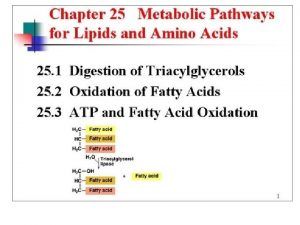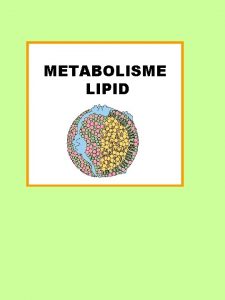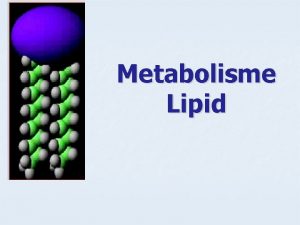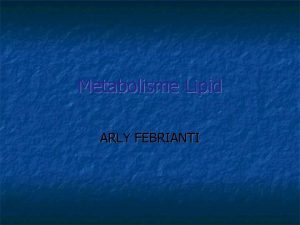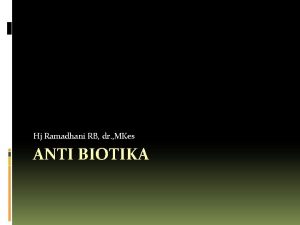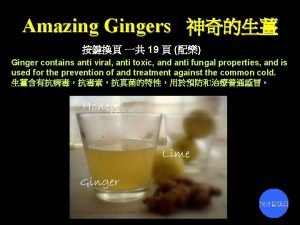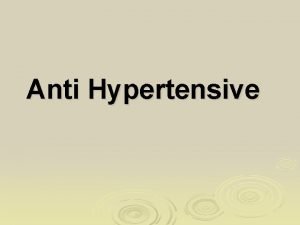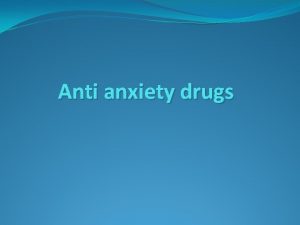Lipid Evolution Lipid Ev for short anti An
















- Slides: 16

Lipid Evolution Lipid. Ev (for short) anti An Inflammatory Story ^ Derek W. Clissold

Early Days • Ph. D. Novel Synthesis of Leukotrienes LTB 4 , LTD 4 - inflammatory mediators • Head of Process R & D Lilly Research Centre • 1984 - Chemistry Dept. Reading. Post Doc, CRC - Prof. John Mann • 1985 - Cascade Biochem Ltd, start up in Chem Dept - 2 staff • 1987 - Expansion into Innovation Centre - small scale production and R & D, Leukotrienes and Prostaglandins • Further expansion into STC 1999 20 staff - small scale production and R & D • 2001 total 50 staff : VC investment-Cork GMP production facility, successful FDA inspection- Misoprostol, Latanoprost, LTB 4 - as antiviral • 2002 -2006 acquisition by Johnson Matthey PLC


2 nd Time Around! Again at the STC…. ‘Lipid Evolution’ start up 23 rd June 2014 Lipid. Ev Ltd. But first more background on Inflammation…………

Inflammation Primer • Inflammation is a complex, protective, generic biochemical response to pathogen invasion, tissue injury or irritants. • Leukotrienes (LTB 4, LTD 4) and other pro-inflammatory lipid mediators including prostaglandins (PGs) and thromboxane (TX) are initially biosynthesised locally from arachidonic acid (AA), play key roles and cause the physical symptoms of pain, swelling, redness, heat and loss of function. • Inflammation does not, as was previously thought, just resolve ie. ‘clear up’ in a passive process.

Inflammation Primer Cont. • Instead resolution requires the local bio-synthesis of the recently discovered Specialized Pro-resolving Mediators (SPMs) to actively resolve acute inflammation and prevent the progression to persistent chronic inflammation thus inhibiting further tissue damage and enabling return to homeostasis. • In the acute phase a class switch is observed, with time, from proinflammatory mediators to the SPMs. • While generally not a causative factor chronic inflammation is now accepted to play a significant role in the aetiology of a very wide range of diseasesparticularly those prevalent in ageing populations. • Various SPMs are observed to be deficient alongside pro-inflammatory mediators in excess in chronic inflammatory conditions.


Specialised Pro-resolving mediators (SPMs) are…. . • Highly potent (at nanomolar/picomolar levels) bioactive molecules derived, via lipoxygenase enzymes, from the essential (ie. required in the diet) precursor omega-3 fatty acids (EFAs) EPA and DHA -the primary constituents of marine oils. • There are four classes of SPMs ie. lipoxins, resolvins, protectins and maresins each with distinct chemical structures and functions ranging from limiting infections (sparing for anti-biotics) to tissue regeneration. Twenty five SPMs have so far been identified. • The biosynthesis of the SPMs from EFAs becomes less efficient with ageing thus opening the door to the possibility that supplemenation with SPMs or stabilised analogs may give rise to some level of rejuvenation. • The SPMs actually activate the process of inflammation resolution. • As anti-inflammatories they reduce pain and unlike current analgesics are not immunosuppressive.


Aspirin. . . The Collaborator! • The presence of aspirin uniquely facilitates and jump starts the resolution of inflammation. • Aspirin acetylates the COX-2 enzyme present which in turn causes the rapid formation of alternative structure SPMs. • These so called ‘Aspirin Triggered’ (‘AT’) SPMs from EPA and DHA are equivalent in biological activity but more metabollicaly stable than their counterparts. • Stabilized SPM analogues based on the AT-SPM structure are being developed. • Unlike aspirin most NSAIDs (eg Ibuprofen) reversibly inhibit COX enzymes and can delay complete resolution. • Some selective COX-2 inhibitors, which totally prevent the formation of the highly beneficial AT-SPMs, have recently been withdrawn from the market. Take a baby aspirin with your omega-3 s

Pro-Inflammatory Mediators Anti-Inflammatory Mediators (SPMs) (biosynthesis from ω-6 AA) (biosynthesis from ω-3 EPA, DHA) Cascade Products Lipi. Dev Future Products The synthetic technology developed at Cascade Biochem for the Leukotrienes (and similar molecules) now greatly assists in the total synthesis of the SPMs.

The Potential for SPM Pharmaceuticals • The discovery of the SPMs and their biological actions now finally provide an understanding of the mechanism of action for the beneficial effects of consuming ω-3 EFA fish oils (ie. EPA and DHA). • In addition to their powerful anti-inflammatory actions certain of the SPMs aid in the process of tissue repair (including nerve tissue), enhance wound healing, prevent bone loss, have strong analgesic properties, have anti-bacterial actions and are sparing in the use of anti-biotics. • Existing anti-inflammatory/analgesic drugs such as NSAIDs, steroids, opioids, and antihistamines have many undesirable side effects, in particular they can be immunosuppressive.

The Potential for SPM Pharmaceuticals Cont. • The discovery of the natural endogenous SPMs offers an alternative approach to the development of novel anti-inflammatory/analgesic therapeutics based on the SPM mechanisms that switch off acute inflammation and bring about its resolution. • As these new drugs will be/are based on the natural endogenous SPMs the side effect profile is likely to be very low. • Pharmaceuticals based on the more stable AT-SPMs stereochemistry can be further stabilized against metabolic degradation via structural modifications of the natural molecules.

The Potential for SPM Pharmaceuticals Cont. • Chronic inflammatory conditions in which SPMs are proven to be effective or in which biomedical research is currently underway include… metabolic syndrome (heart disease, stroke, diabetes), lung disease, allergic, respiratory (asthma), cardiovascular, cancers, neurologic (dementias: alzheimers, parkinsons), peritonitis, bacterial, fungal, periodontal, musculoskeletal, hormonal, visual, pulmonary and gastrointestinal conditions. • With clinical trials programmes already underway this strategy is showing great promise for the future pharmaceutical management of inflammation based diseases. • The potential application of the SPMs within the nutrition and cosmetics fields similarly has very large potential and is beginning to be exploited.

With huge thanks to Dr. Charles N. Serhan

Many thanks for attending. Any Questions?
 Short short short long long long short short short
Short short short long long long short short short Anti a and anti rh blood type
Anti a and anti rh blood type Elektronik för barn
Elektronik för barn Borra hål för knoppar
Borra hål för knoppar A gastrica
A gastrica Smärtskolan kunskap för livet
Smärtskolan kunskap för livet Bris för vuxna
Bris för vuxna Bra mat för unga idrottare
Bra mat för unga idrottare Novell typiska drag
Novell typiska drag Frgar
Frgar Teckenspråk minoritetsspråk argument
Teckenspråk minoritetsspråk argument Humanitr
Humanitr För och nackdelar med firo
För och nackdelar med firo Toppslätskivling effekt
Toppslätskivling effekt Rita perspektiv
Rita perspektiv Debattartikel mall
Debattartikel mall Redogör för vad psykologi är
Redogör för vad psykologi är

















